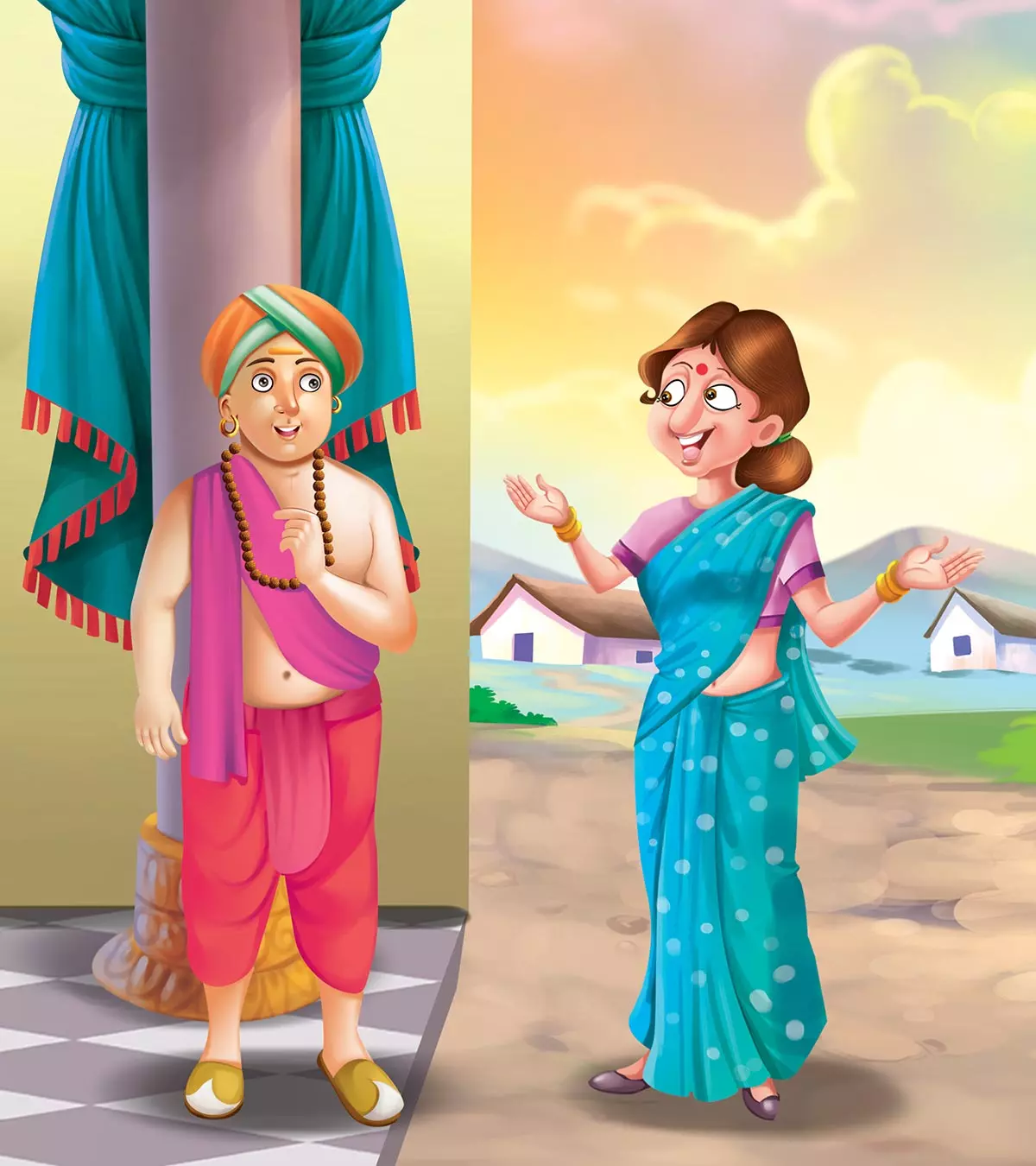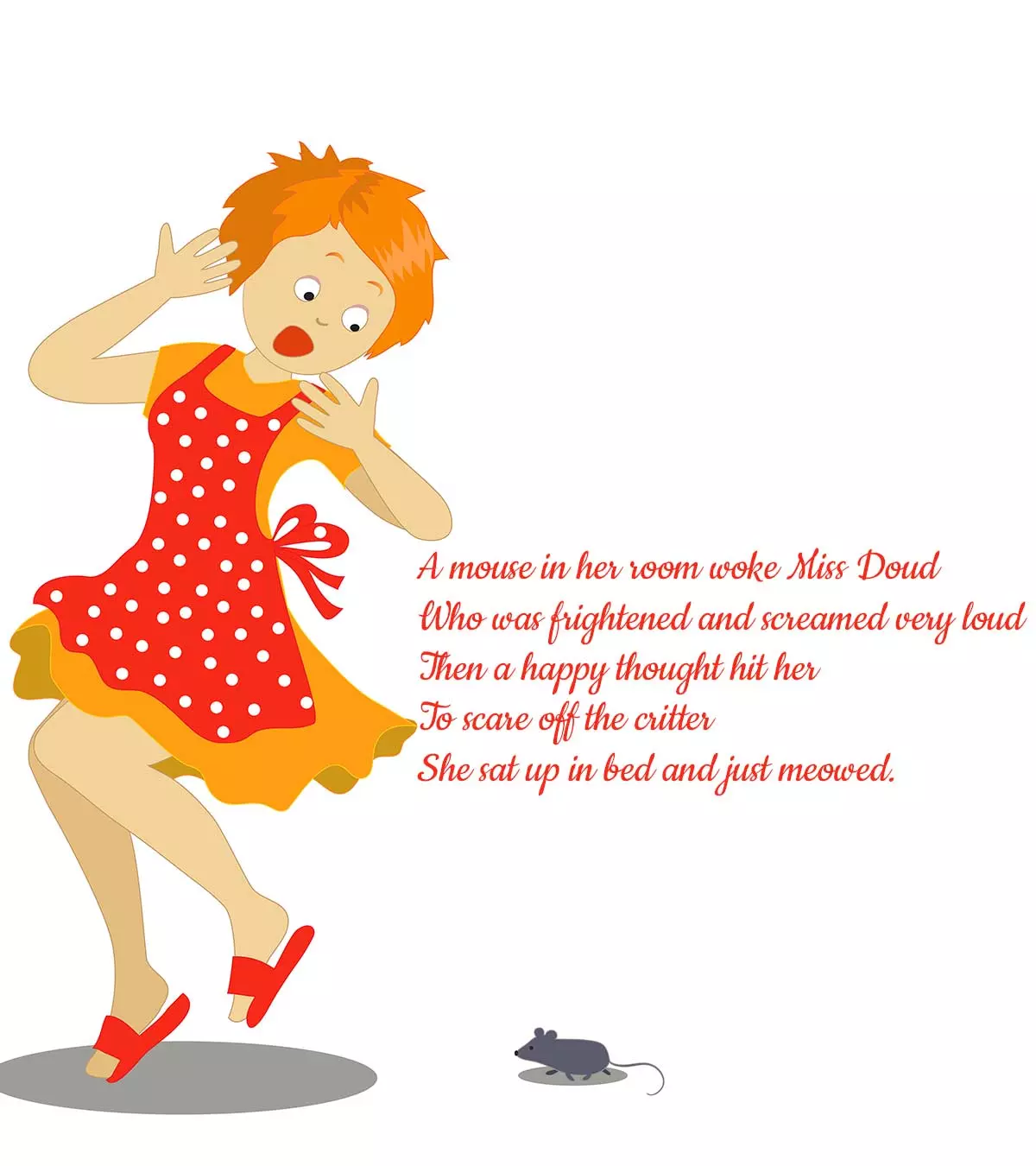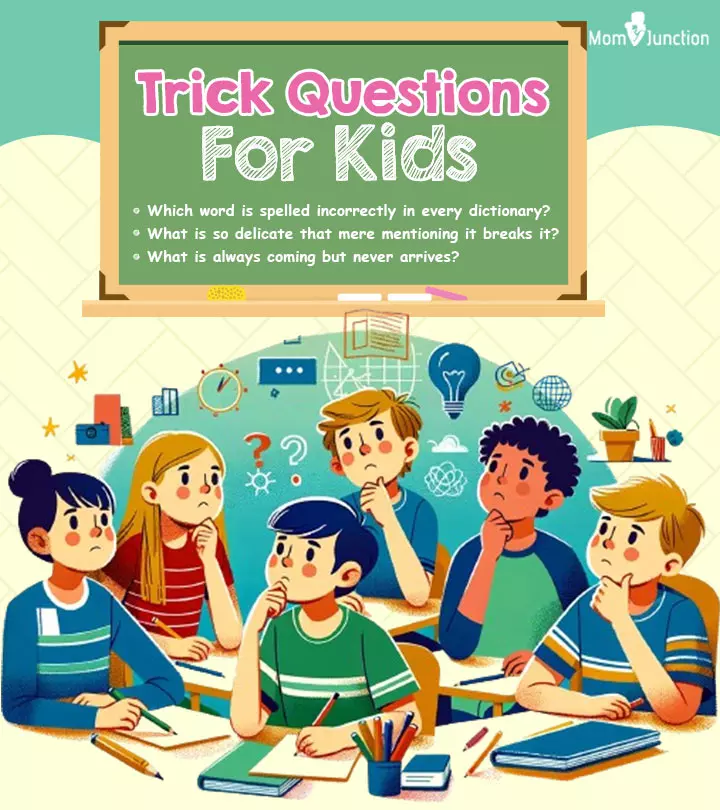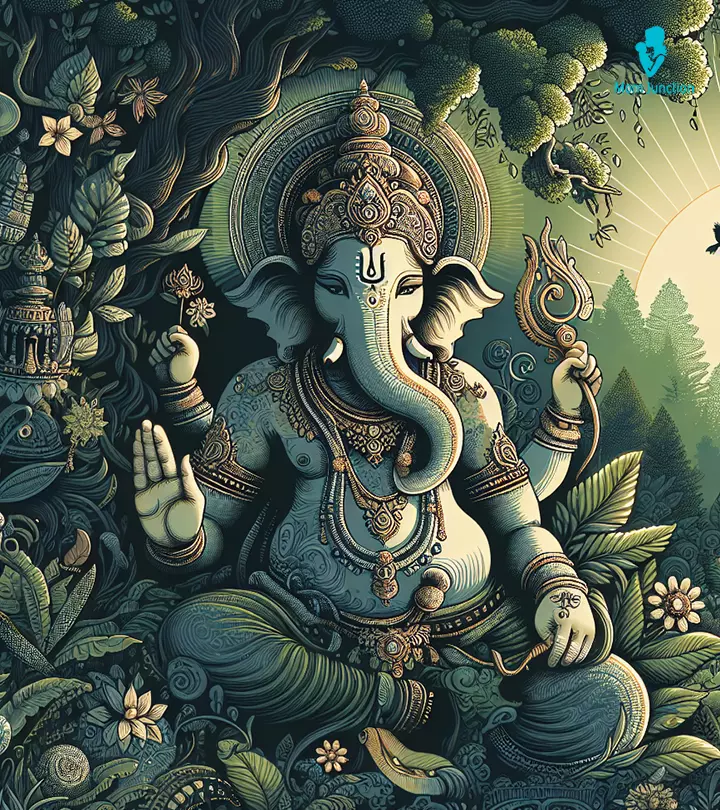
Image: Midjourney/ MomJunction Design Team
If there is something that is universally adored by most children, it’s reading about mythology. Like most of the world mythology, Hindu mythologyiDetailed study of Hindu literature obtained from the Vedas and epics such as Ramayana and Mahabharata. has plenty of gods and goddesses. Lord Ganesha stories for kids are said to be the most entertaining since most kids are fans of his. They love Ganesha, the elephant-headed God. Ganesha is one of the popular Hindu deities and has a lovable persona and has a lot of entertaining stories to his name. So if your kid enjoys learning about Hindu mythology, look no further and keep reading this mythology for children.
Key Pointers
- In Hinduism, Lord Ganesha is considered the first God and the God of the masses.
- His stories depict his unmatchable wisdom.
- Children also learn valuable lessons that can be implemented to live a fulfilling life.
- These stories also promote love and positive thinking in children.
Who Is Lord Ganesha?
Ganesha is the first son of Lord ShivaiFondly called “Mahadev” by followers and is the third God of Trimurti (Trinity) for the destroyer of the world. and Goddess ParvatiiThe Goddess of the Himalayas who is known for her gentle and nurturing nature. . He is considered as the “First God” in Hindu mythology.
- The name of Ganesha is derived from two different Sanskrit words: “isha”, meaning Lord and “gana” meaning group. Hence, Ganesha is considered as the God of masses.
- Ganesha can be spotted in different postures such as lying, enjoying a candy, dancing or riding on a mouse.
- This explains why kids are fascinated by Lord Ganesh and love to hear various stories about him.
7 Best Stories Of Lord Ganesha For Kids
Following are some of the interesting stories of Lord Ganesha for kids. We hope you have a good time with your kids when you tell them these stories.
1. Lord Ganesha and the Kaveri river
This Lord Ganapathi story is a favorite among kids. Once upon a time, Sage AgastyaiAn Indian sage of Hinduism in the Vedic period and an influential scholar of Sanskrit. sought the blessings of Lord BrahmaiConsidered the first God of Trimurti (Trinity) for the creation of the world that beings reside in. and Shiva.
- The sage wished to create a flowing river in a suitable location to offer water to the southern lands. The Gods, listening to his prayers, had his kamandaluiAn oblong pot for carrying water. filled with sacred water.
- The Sage then reached the Coorg Mountains. On his way, he spotted a small boy and requested him to take good care of his pot containing water as he needed to go to the toilet.
- The small boy was none other than Ganesha, and he placed the small pot on the ground as he felt that the location was perfect for a river.
- Then, a crow landed on this pot, and Sage Agastya shooed off the bird. The crow flew off, tipping the pot to the ground, and spilled off some water.
- This water formed the River Kaveri, which is considered a sacred river.
Moral:
Every action happens for a good cause. So do not be worried even if something bad happens in your life, eventually there will be a good ending.
2. Lord Ganesha and Lord Kubera story

Image: Shutterstock
Kubera, God of Wealth, was quite proud of the fact that he was the richest God. One day, he held a lavish dinner and invited many popular guests, among them were Lord Shiva and Parvati.
- As the Divine couple could not attend the dinner, they sent their son, Ganesha who was a small child.
- Ganesha began to devour all the food and soon there was no food available in the venue.
- He then began to eat all the vessels, dishes, furniture and other things at Alakapuri, Kubera’s city.
- Ganesha then proceeded to swallow the host of the dinner and the terrified Kubera ran to Lord Shiva’s abode and sought his help.
- Lord Shiva handed a cup of roasted cereals to Ganesha and his hunger for food ceased immediately.
- Lord Kubera realized his mistake and sought forgiveness for his pride.
Moral:
Do not be proud of what you possess. Instead, concentrate on how you can make use of your possession for good things.
 Trivia
Trivia3. Lord Ganesha and Goddess Parvati
This Bal Ganesha story for kids would teach them that they have to take care of animals in a gentle way.
- One day, child Ganesha was playing with a cat and was tormenting the animal by pulling his tail and throwing him on the ground.
- He left the cat and went to Mount Kailash to meet his mother Goddess Parvati.
- He was shocked to see her wounded.
- When he asked her about it, his mother replied that it was his action that caused the wound. As she was playing with him disguised as a cat.
- She also said that it is unfair to treat animals cruelly and Ganesha was sorry for injuring the cat.
Moral:
Animals have every right to live in this world, just as humans do. So do not cause any injury or ill treatment of any animal.
4. Lord Ganesh and Karthikeya story
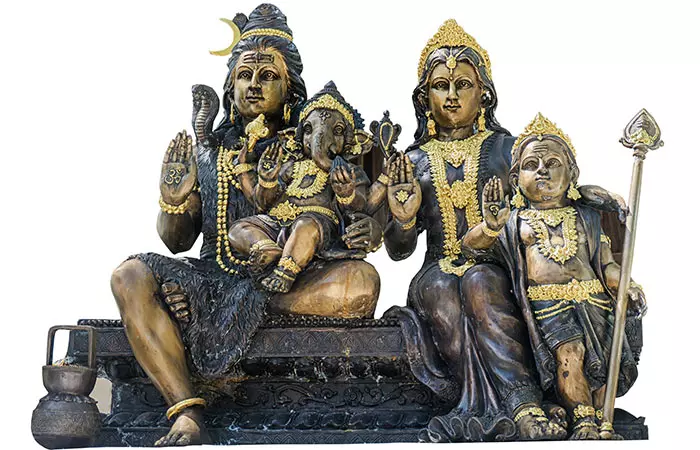
Image: Shutterstock
One day Ganesha and his younger brother Karthikeya were playing. They received a special fruit from the gods. Being kids, they were not ready to share the fruit.
- Their parents, Lord Shiva and Parvati said that the first one who goes around the world thrice would get this fruit of immortality and supreme knowledge.
- Karthikeya climbed on his peacock at once and set off to win the fruit.
- Ganesha was worried about winning the race as he had a stout appearance, and his vehicle, the Mouse, did not have wings!
- Later, he made a decision based on his wisdom and asked the permission of his parents to revolve around them thrice as he felt that his parents were his universe.
- Ganesha won the race and the fruit.
Moral:
This story of Ganesha has two morals.
- Use of wisdom at the right time and right place.
- Respect your parents; there can be no one as important as them in your life!
5. Lord Ganesha and Lord Shiva
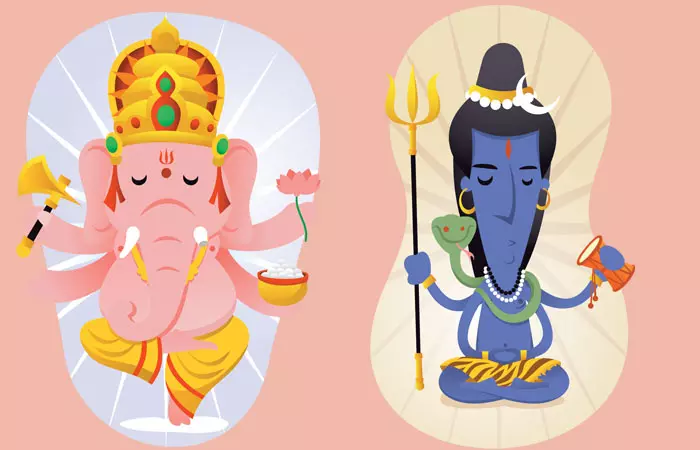
Image: IStock
When Lord Ganesha was born, Lord Shiva made a rule that Lord Ganesha must be worshiped first to ensure success in any endeavor.
- However, Lord Shiva forgot about his own rule and left for a war with the demons in Tripura. He did not worship Lord Ganesha before doing so!
- While he was on his way in his carriage, the wheel peg got damaged.
- It was only then Lord Shiva remembered that he forgot to offer prayers to Lord Ganesh before departing for the war.
- He offered his prayers to Ganesha and proceeded to the battle ground. Lord Shiva won the war!
Moral:
You must follow certain rules, even if you feel you are exempt from doing so.
 Trivia
Trivia6. Lord Ganesha and Lord Vishnu
One day, Lord Vishnu’siThe second God among Trimurti (Trinity), considered the preserver of the world. Valampuri Shankh (conch) was missing, which annoyed him greatly.
- Later, he heard the sound of his conch at a distance, and it was coming from Mount Kailash, the abode of Lord Shiva.
- He sought the help of Lord Shiva and requested him to ask his son, Lord Ganesh, to give back his conch.
- Lord Shiva asked Vishnu to perform a puja to please Lord Ganesha.
- Lord Vishnu performed the puja immediately, and Ganesha was happy with it and returned his conch.
- After this incident, Lord Ganesha was known as Valampuri Ganesh, which means Ganesha with a trunk facing the right side.
Moral:
There is no moral in particular, but your kids can know the different names of Lord Ganesh.
7. Lord Ganesha and the Moon
This story teaches how the different phases of the Moon came to be. One day, Lord Ganesha, known for his love for food, was invited to a grand feast.
- After enjoying a variety of delicious dishes, his belly was full.
- Later, as Ganesha rode home on his mouse, he stumbled, and his belly burst open. He quickly fixed it, but the Moon laughed at him.
- Hurt by the Moon’s mockery, Ganesha cursed it to disappear from the sky.
- The Moon apologized to Ganesha, realizing its mistake. Touched by its sincerity, Ganesha modified the curse, allowing the Moon to wax and wane rather than disappear entirely.
Moral:
One must not laugh at another’s misfortune
Frequently Asked Questions
1. Why is the story of Ganesha important for kids?
The moral stories of Lord Ganesha teach about valuing and respecting our parents and elders. He is also known as the Deva of intellect, prosperity, wisdom, and the remover of obstacles who never accept defeat. He is also one of the most celebrated gods in Hinduism. So, by telling your children Lord Ganesha’s story, you can instill his teachings and morals in them.
2. How do I explain Ganesha to a child?
Lord Ganesha, or Ganapati, can be described to your children as a big-bellied, yellow, or red God with four arms, holding an ax, whip, lotus, and one hand giving blessings to his devotee. He has the head of an elephant and rides on or is followed by a mouse named Mooshak; he enjoys sweets, particularly modaka. His birthday is celebrated as Ganesh Chathurthi, one of the greatest Hindu festivals. You can give your child some Lord Ganesha coloring pages to offer them a clearer understanding of the God’s appearance.
3. How did Lord Ganesha become the Lord of beginnings and remover of obstacles?
Goddess Parvati created Ganesha as a boy out of turmeric paste to guard the entrance of her bathing area. But Lord Shiva didn’t know this and cut off the boy’s head. When he learned that he was Ganesha, he replaced the boy’s head with the head of an elephant. He also granted a boon saying that Ganesha would be worshiped before everyone else and be the remover of all obstacles.
4. What are some of the different forms of Lord Ganesha and their significance?
There are 32 forms of Lord Ganesha. Bala Ganesh is the child form of Lord Ganesha and is believed to free His followers from sins. Bhakti Ganesh is the devotee form of Lord Ganesha. Dvija Ganesh means ‘twice-born,’ considered to be equivalent to Lord Brahma, the God of creation. Heramba Ganesh is the devoted son of Goddess Parvati, has five heads and ten hands, rides a lion, and protects the weak.
5. How do people celebrate the festival of Ganesh Chaturthi in India and other parts of the world?
In the Western states of Maharashtra, Goa, Madhya Pradesh, Gujarat, and Rajasthan, huge pandals are erected, and Ganesh idols are placed for devotees to congregate, worship, sing, and dance. Ganesh Chaturthi is also celebrated in the Eastern states of West Bengal, Odisha, and the North-Eastern state of Assam. However, the festival is celebrated more traditionally in South India, Karnataka, Andhra Pradesh, Telangana, Tamil Nadu, and Kerala. Outside India, different Hindu organizations, such as The Hindu Culture and Heritage Society in London and the Shri Maharashtra Panchayat in Pakistan, celebrate Ganesh Chaturthi. It is also celebrated in countries like the US, Canada, Mauritius, Singapore, Malaysia, and Ghana.
6. What is the significance of Lord Ganesha’s vehicle, the mouse?
There are several beliefs surrounding the mouse as Lord Ganesha’s vehicle. Some believe that the mouse signifies ego and Lord Ganesha riding him is a sign that we must control our ego just like He has managed to. Another myth is that Ganesha can enter into the tiniest nooks and crannies to remove all obstacles, thanks to his small vehicle. Yet another myth states that the mouse was an Asura who Ganesha bested. The Asura became a mouse to seek retribution and agreed to be Lord Ganesha’s vehicle. In all the stories, the mouse is seen to help Ganesha overcome obstacles and find the right way.
7. How did Lord Ganesha become the patron of arts and sciences?
Lord Ganesha is known for his intellect and wisdom in all fields, including the creative arts. Hence, he is often depicted holding a book or playing musical instruments. That’s how he is known as the patron of arts and sciences.
8. Can you tell how Lord Ganesha helped a poor farmer?
Once all the other Gods tricked Lord Ganesha into watching Swarga while they went to attend Lord Vishnu’s wedding with Goddess Lakshmi. Lord Ganesha understood and decided to teach them a lesson. He sent his vehicle, the mouse, to dig up all the roads leading to Goddess Lakshmi’s house. While everyone struggled to move on the streets, a poor farmer had a rough time pushing his cart. But as he invoked Lord Ganesha’s name, his path was cleared immediately, and he could drive his cart easily. He explained to everyone how taking Lord Ganesha’s name helped him.
9. What is the importance of worshipping Lord Ganesha during the festival of Ganesh Chaturthi?
Worshiping Lord Ganesha during Ganesh Chaturthi denotes the endless cycle of birth, life, and death. It is believed that Lord Ganesh comes to earth for ten days and then returns to his celestial abode after immersion. It is also a common belief that he takes away all our obstacles and the pain of the devotees as he leaves.
Stories are beneficial for children. Mythological stories for kids on devotion help children learn moral values, virtues and also make them understand our culture. Stories also help children improve language skills, develop curiosity, enhance concentration, and teach empathy. Indian mythological stories for kids about Lord Ganesha will help children get answers to their questions, and they can pass from one generation to the other. These stories will teach children how to differentiate between good and evil. They can enjoy listening to and reading the stories and get on to a positive mindset.
Illustration: Memorable Lord Ganesha Stories For Kids

Image: Dalle E/MomJunction Design Team
Get immersed in the amazing story of Bal Ganesha, the beloved elephant-headed god, and learn the moral of his divine birth. Enjoy this English animated cartoon and be inspired!
Community Experiences
Join the conversation and become a part of our nurturing community! Share your stories, experiences, and insights to connect with fellow parents.
Read full bio of Visti Larsen
Read full bio of Harshita Makvana
Read full bio of Deepa Thomas







